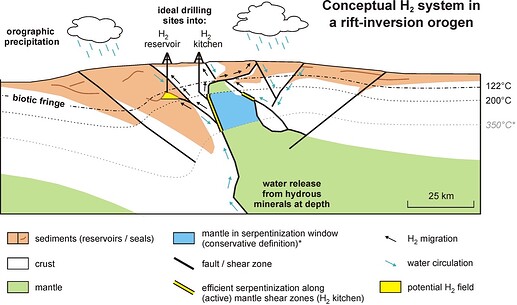| . |
Research Highlight
Numerical geodynamic modelling shows mountain ranges to be potential natural H2 hotspots
Naturally occurring hydrogen gas (H2) represents a potentially major source of clean energy that has been gathering significant attention in recent years (e.g., Osselin et al., 2020; Gaucher et al., 2023; Ellis et al., 2024). There are various potential sources of H2 in nature, but the most promising mechanism for large-scale natural H2 generation is serpentinization of mantle material. Serpentinization occurs most efficiently when mantle material reacts with water as it is tectonically brought into the “serpentinization window” (conservatively defined as the 200-350˚C temperature range) during exhumation. Such mantle exhumation is frequently observed in rift and oceanic basins, as well as in mountain ranges, but the implications for serpentinization and natural H2 generation remain poorly constrained.
Therefore, we study the potential for serpentinization-related natural H2 generation ... [full article]
contributed by:
Frank Zwaan(1-3); Sascha Brune(1,4); Anne C. Glerum(1), Dylan A. Vasey(5), John B. Naliboff(6), Gianreto Manatschal(7); Eric C. Gaucher(8)
(1) GFZ Helmholtz Centre for Geosciences, Potsdam, Germany,
(2) University of Fribourg, Fribourg, Switzerland,
(3) University of Lausanne, Lausanne, Switzerland,
(4) University of Potsdam, Potsdam, Germany,
(5) Tufts University, Medford, USA,
(6) New Mexico Institute of Mining and Technology, Socorro, USA,
(7) University of Strasbourg, CNRS, ENGEES, Strasbourg, France,
(8) Lavoisier H2 Geoconsult, Chamonix, France.
From HQ
Summer was extraordinarily busy this year. We organized two hackathons and, of course, our community meeting 2025 CIG TNG. I had the pleasure of talking with many of you at these events and learned about the breadth of research undertaken and the new directions explored that help keep this a vibrant community. This quarter's Research Highlight spotlights some of these efforts in demonstrating the real-world applications of computational modeling. As we undergo a shrinking funding environment, highlighting the importance of the work we do contributes to the importance of continued funding for the sciences. Please feel free to email me, letting me know more about your broader impacts. We are happy to repost your geodynamic highlights through our LinkedIn account CIG-geodynamics.
If you were one of the 70+ participants who joined us this month in Breckenridge, Colorado, for the 2025 CIG TNG meeting, thank you for contributing to the tutorials, breakouts, and plenary discussions. The Organizing Committee is busy distilling the feedback we received on geodynamics across disciplines, new computational horizons, and applications of ML. The way we translate this to infrastructure in support of your research depends on the contributions from the community. Share your ideas by contacting either Louis Moresi or me directly. In addition, look for opportunities to join a new Working Group in the coming year.
Fall Elections. Running for Governance is another great way to become involved. We are currently seeking nominations for the Executive and Science Steering Committee. Members will not only be tasked with strategizing the next steps for the last two years of CIG IV, but also be more forward-looking to CIG V. Submit a ticket with your nominations.
Lastly, don't miss the deadline August 31, 2025 to apply to host one of our two Distinguished Speakers: Prof. Vedran Lekic, University of Maryland, College Park, Decoding Earthquake and Marsquake Waveforms to Reveal Planetary Interiors or Prof. Shi Joyce Sim, Georgia Institute of Technology, Dynamic habitability: From mid-ocean ridges to Europa. See the website for more information.
Lorraine Hwang, Co Director
Remember to join our forum to receive announcements for these and other 2025 events.
The Computational Infrastructure for Geodynamics is supported by the National Science Foundation under NSF 2149126.

